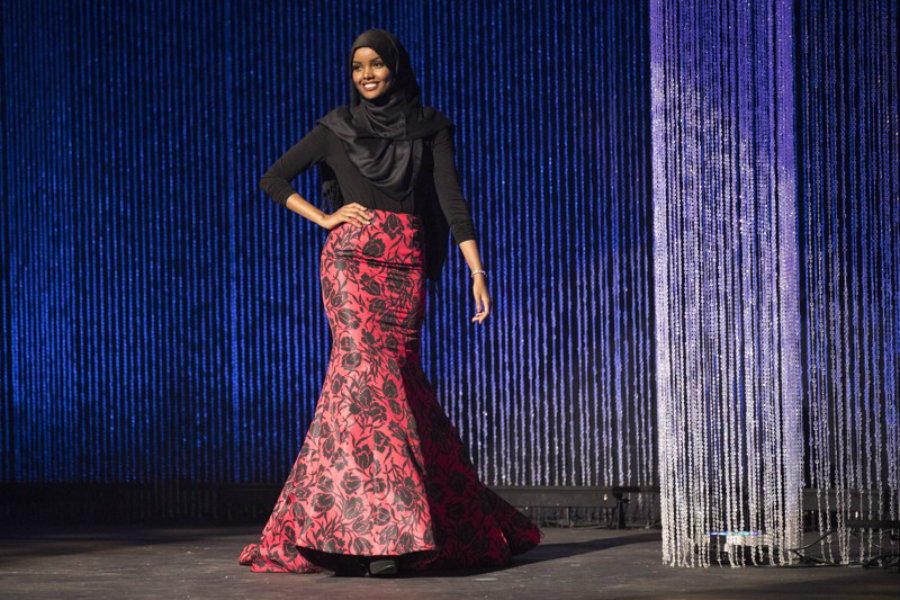Halima Aden brought her hijab-inspired bathing suit to the swimsuit round of Miss Minnesota USA pageant.
Although the 19-year-old Somali-American did not make it to the finalists’ round, she announced that she was able to encourage women to wear what they wanted and felt was right with their beliefs.

Aden stated that the Miss Minnesota USA pageant is an event that not only evaluates beauty but also beauty in confidence, which is why she wore her hijab as she participated in the swimsuit round.
Trump’s election has raised fear among Muslim women, who have to cover their heads and bodies to comply with Islamic tradition. Coincidentally, the Miss USA competition is a part of the Miss Universe organization, which was once owned by the President-elect.
The difference between hijab and burka is that hijab is the headscarf that Muslim women wear to cover their head and neck, leaving their shoulder line able to be seen. Burkas, on the other hand, are the most concealing of all veils, covering the face and the body, leaving a tiny slot or mesh screen for the eyes to see through.
Wearing a hijab because she wants to
A freshman at St. Cloud State University, Halima Aden wishes to be a UN ambassador, migrated to the U.S. at the age of 7. She used her opportunity at the pageant to try and change the perception of Islam, seeing that many believe Muslim women are oppressed and are forced to wear their veils.
“A lot of people will look at you and will fail to see your beauty because you’re covered up and they’re not used to it. So growing up, I just had to work on my people skills and give people a chance to really know me besides the clothing. Be who you are. It’s easy to feel like you have to blend in, but it takes courage to live your life with conviction and embrace the person that you are,” she stated to Kare 11.
Aden stated to CBS that, as she started to grow older, she realized that being different is not bad, but rather an opportunity to stand out and to mark a difference. She firmly took up the challenge of being the first Miss USA beauty pageant contestant to wear a Muslim veil.
She did not win the pageant but was able to make history with her audacity and confidence.
Why Muslim women wear veils?
People often have the perception that Muslim women are forced to wear the hijab or some sort of veil when in the presence of adult males that do not belong to their family. Some argue that they “want to” out of fear of being punished, or that it is still considered oppression under any circumstance. The truth is that the choice of wearing a veil depends on the woman itself, but considering that Aden lives in Minnesota, it is a different scenario when a Minnesota teen chooses not to wear a veil compared to a housewife in Saudi Arabia.
According to tradition, women should conform to a perception of modesty. In Islamic societies, women are frequently secluded from males, which is also one of the customs that go in hand with wearing a hijab. Some interpretations of the Qur’an state that Muslim women should cover everything but their face, knees, and elbows, while others suggest that the Qur’an does not explicitly say that women should wear a hijab at all.

The Qur’an reads that women should “lower their gaze and guard their modesty,” avoid displaying their “beauty and ornaments” when in the presence of sexually-aware male adults, and should also restrain from striking their feet “to draw attention to their hidden ornaments.”
The imperative sense of women having to wear a veil comes from Muhammad’s interpretation of God’s command dictating that his wives should cover themselves up to avoid being harassed by others.
How much should women cover with their veils is usually determined by their local cleric, seeing that some forbid exposing hands and feet. The consensus is that Muslim veils should not allow the curves of the body to be seen with clarity
Wearing a veil or not can also be decided by the women itself, as the only explicit rule concerning clothing stated in the Qur’an refers to modesty. Scholars point out that women covering their heads is a tradition that has existed even before the revelations of the Qur’an, which is why it should not be forcibly bound to Islamic tradition.
One of the most high-profile women that do not always wear a veil is Queen Rania of Jordan, who married King Abdullah II on 1999. She has worked with Citibank and Apple and has publicly stated that women should choose whether to wear a veil or not as long as it is not under pressure or for enforcing a tradition. Queen Rania wears a veil mostly in formal settings, such as weddings and meetings with religious officers.
As a queen and business administration professional, Queen Rania has taken the time to develop her online presence and advocacy for human rights and development, being followed by millions of users on Twitter, Facebook, and Youtube.
Source: People
